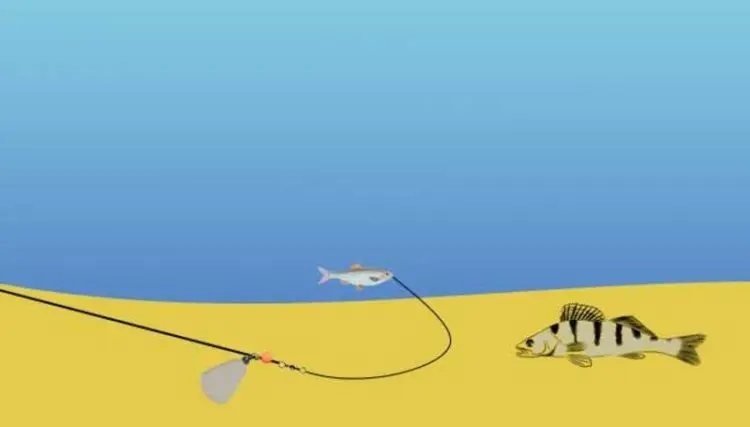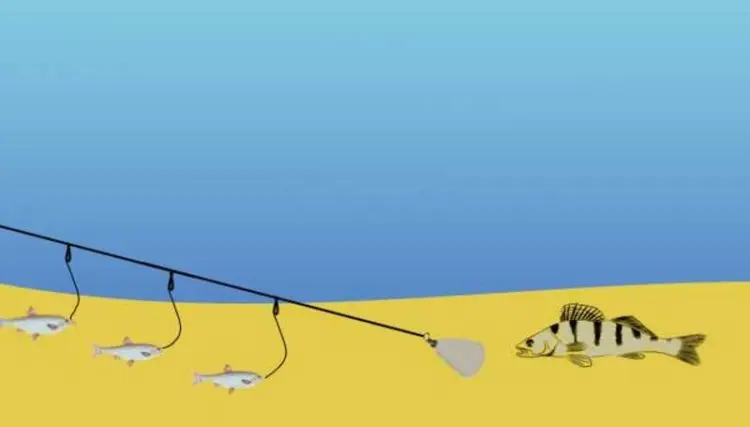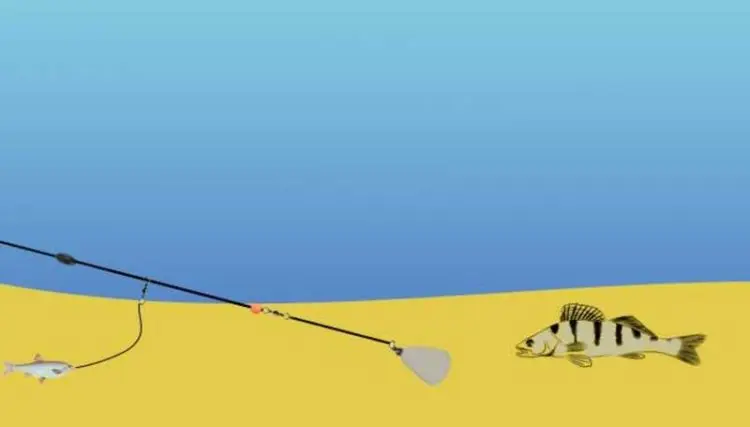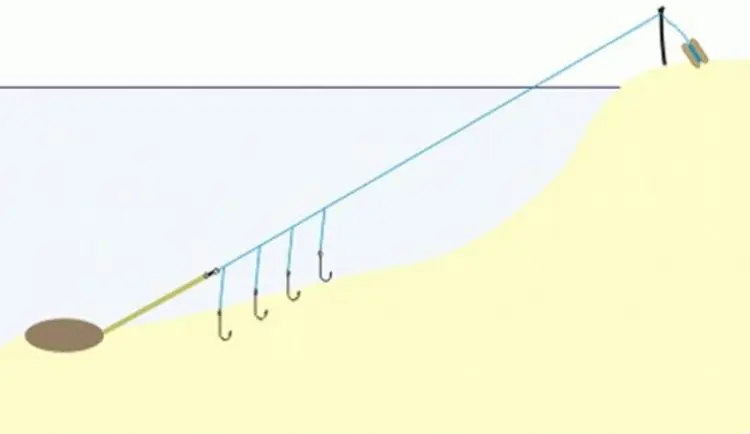Bottom tackle shows good results when fishing for walleye from the shore. Having learned how to correctly assemble various equipment mounts, the angler will be able to successfully fish both in still water and in the current.
With one hook
The most versatile is the installation with one hook on a long leash. This option of equipment works stably on any type of reservoirs. To assemble it you will need:
- lead weight weighing 40-80 g, having a wire “eye”;
- silicone bead acting as a buffer;
- medium size swivel;
- a lead element made of fluorocarbon monofilament with a cross section of 0,28–0,3 mm and a length of 80–100 cm;
- single hook No. 1/0.
The pike-perch bottom should be completed with lead sinkers of the “bell” or “pear” type. Such models are distinguished by good aerodynamics, which in turn allows you to perform the longest casts. This is especially important when fishing takes place on large lakes and reservoirs, where the parking areas of the fanged predator can be located at a considerable distance from the coast.

Photo: www.class-tour.com
The silicone bead used in the assembly acts as a buffer. It protects the connecting unit from mechanical loads that occur when casting equipment and playing fish.
The swivel prevents twisting of the leash during fishing. This element also gives the bait bait greater freedom of movement, which contributes to a better attraction of the predator. Since a trophy weighing over 5 kg can fall on the hook, the swivel used must have a good margin of safety. Otherwise, you will not be able to pull out large fish.
The leash in this type of equipment should be at least 80 cm long – this will allow the live bait to move actively, attracting the attention of zander faster. The leader element is made of fluorocarbon fishing line, which is distinguished by:
- increased rigidity;
- absolute transparency in water;
- good resistance to abrasive loads.
Due to the rigidity of the fluorocarbon, the risk of tangling the leash during the cast is reduced. The absolute transparency of this type of line makes the rig almost invisible to fish – this plays an important role when fishing passive pike perch, which is characterized by increased caution. Catching a fanged predator is usually carried out on hard ground with the presence of stones and shells, so the good abrasion resistance of the “flure” is a very valuable quality.
In this type of equipment, a relatively small hook No. 1/0 (according to international standards) is used, made of thin wire. This option will not hinder the movement of live bait and will allow the fish to behave more actively.
When catching “fanged” on the bottom, hooks with an average length of the forearm and a semicircular shape of the bend are used. On them, the live bait is held more securely, without flying off when performing power casts.

Photo: www.fisherboys.ru
To assemble a bottom mount with one hook, designed for angling walleye from the shore, you will need to perform the following steps:
- Insert the end of the main monofilament into the “eye” of the load;
- Put a buffer bead on the monofilament;
- Tie a swivel to the monofilament (with a clinch or palomar knot);
- Tie a leash with a hook to the free ring of the swivel.
When assembling the installation, you need to pay attention to the manufacture of connecting nodes, since the overall reliability of the equipment will largely depend on this.
With multiple hooks
When fishing for “fanged” on rivers with an average flow rate, bottom mounting should be used, equipped with several hooks on short leashes. To assemble it you will need:
- high-quality “flur” with a thickness of 0,28-0,3 mm (for leashes);
- 4–6 крючков №1/0–2/0;
- sinker of the “medallion” type weighing 60–80 g.
In this type of equipment, the length of the lead elements is about 13 cm. The fish swimming nearby create the illusion of fry feeding near the bottom, which quickly attracts the attention of pike perch.
Since the freedom of movement of the live bait is limited by the short length of the leaders, larger hooks (up to No. 2/0) can be used in this type of mounting. This will make the tackle more reliable and will allow for forced hauling of fish in current conditions.

Photo: www.fisherboys.ru
When fishing on the river, the donka should be equipped with a flat sinker of the “medallion” type. It flies a little worse than pear-shaped models, but it keeps the rig well in the current, preventing it from moving from the perspective point.
This type of equipment is assembled according to the following scheme:
- A piece of fluorocarbon fishing line is cut into individual elements 15 cm long (thus obtaining 4–6 leashes);
- A hook is tied to each of the resulting leashes;
- A weight-medallion is tied to the monofilament;
- A small loop is knitted 40 cm above the medallion sinker;
- 20 cm above the first, formed loop, knit another 3-5 “deaf” loops (20 cm from one another);
- A leash element equipped with a single hook is attached to each of the loops.
When assembling this rig, you need to pay attention so that the distance between the loops connected on the main monofilament is slightly larger than the length of the leashes – this minimizes the risk of overlapping equipment elements.
With sliding leash
When fishing a fanged predator in stagnant water, as well as on slow-flowing rivers, a bottom rig with a sliding leash shows a good result. For its manufacture you will need:
- silicone stopper used in match gear to limit the movement of the float;
- 2 swivels;
- silicone bead that acts as a buffer;
- segment “flure” 30 cm long and 0,4 mm thick;
- segment “flure” 20 cm long and 0,28–0,3 mm thick (for a leash);
- hook No. 1/0;
- lead sinker weighing 40–80 g.

Photo: www.fisherboys.ru
Mounting with a sliding leash is easy. The process of its assembly consists of several stages:
- A silicone stopper is put on the fishing line;
- The monofilament is passed into one of the rings of the swivel;
- A lead element equipped with a hook is tied to another ring of the swivel;
- A buffer bead is put on the fishing line;
- Another swivel is tied to the end of the monofilament;
- A piece of “fluric” 0,4 mm thick and 30 cm long is tied to another ring of the swivel;
- A load is attached to the end of the fluorocarbon segment.
Before starting fishing, the stopper, strung on the main monofilament, must be moved to a distance of about 100 cm above the load – this will increase the free sliding distance of the leash along the monofilament.
The advantage of this mounting is that the sliding design of the leader allows the live bait to move freely in the horizontal plane. Actively moving in the bottom layer, the fish quickly attracts the attention of a predator and well provokes pike perch to attack.
With rubber damper
For angling pike perch on lakes, reservoirs and river bays with no current, bottom tackle is excellent, in the installation of which there is a rubber shock absorber. To assemble it, you will need the following items:
- monofilament 0,35–0,4 mm thick;
- 5–7 leashes 13–15 cm long, made of “flure” with a diameter of 0,28–0,3 mm;
- 5–7 single hooks No. 1/0–2/0;
- rubber shock absorber 5–40 m long;
- a heavy load weighing about a kilogram.
If the equipment is thrown from the shore, the length of the rubber shock absorber should be no more than 10 m. When the installation is brought to a promising point on a boat, this parameter can be increased to 40 m.

Photo: www.fisherboys.ru
In this installation, a heavy load is used. This is necessary so that the equipment does not move from the point even with the maximum tension of the shock absorber.
Donka for pike perch, equipped with a rubber shock absorber, is assembled according to the following scheme:
- At the end of the monofilament, a loop about 5 cm in size is formed;
- 30 cm above the formed loop, 5–7 “deaf” loops are knitted (20 cm from one another);
- A rubber shock absorber is attached to a large loop;
- A heavy load is tied to the shock absorber;
- Leads with hooks are tied to small loops.
When fishing on this installation, it is not required to perform power casts. The rig is smoothly brought to the fishing point due to the shock absorber stretching – this allows the bait to stay alive longer and actively behave on the hook.










